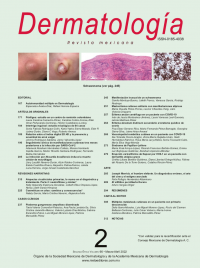Relationship between the 2D:4D digital index and the presence and severity of acne vulgaris.
Dermatol Rev Mex. 2022; 66 (2): 189-195. https://doi.org/10.24245/dermatolrevmex.v66i2.7622
Johnny Rodríguez-Saldaña,1 Jenny Valverde-López2
1 Médico residente de Dermatología.
2 Médica dermatóloga. Jefa del Servicio de Dermatología.
Hospital Regional Docente de Trujillo, Perú. Facultad de Medicina de la Universidad Nacional de Trujillo, Perú.
Resumen
OBJETIVO: Determinar la relación entre el índice digital 2D:4D y la existencia y severidad del acné vulgar en pacientes que acudieron a consulta dermatológica en un hospital regional.
MATERIALES Y MÉTODOS: Estudio transversal analítico, efectuado de enero a junio de 2016 en pacientes mayores de 12 años con y sin diagnóstico de acné vulgar y sin enfermedades androgenizantes y emparejados según sexo que fueron atendidos en el servicio de Dermatología del Hospital Regional Docente de Trujillo, Perú, en el que se determinó el índice digital 2D:4D a través de un calibrador vernier y su relación con el diagnóstico y severidad del acné vulgar a través de una prueba de t para muestras independientes.
RESULTADOS: Se incluyeron en el estudio 245 pacientes con diagnóstico de acné vulgar y 245 controles. La frecuencia de la severidad del acné vulgar leve, moderado, moderadamente severo y severo fue del 25.3, 53.5, 7.8 y 13.5%, respectivamente. El promedio del índice digital 2D:4D en los pacientes varones con acné vulgar fue de 0.917 y 0.937 en la mano derecha e izquierda, respectivamente, mientras que en las mujeres con acné vulgar fue de 0.930 y 0.941 en la mano derecha e izquierda, respectivamente. La prueba de t para muestras independientes de ambas variables en ambos grupos tuvo un valor de p mayor a 0.05.
CONCLUSIONES: No existe una relación significativa entre el índice digital 2D:4D y la existencia y severidad del acné vulgar, principalmente debido a que la patogenia del acné vulgar es multifactorial.
PALABRAS CLAVE: Acné vulgar; Dermatología.
Abstract
OBJECTIVE: To determine the relationship between the 2D:4D digital index and the presence and severity of acne vulgaris in patients who attended a dermatological consultation at a regional hospital.
MATERIALS AND METHODS: Cross-sectional analytical study, carried out from January to June 2016 in patients older than 12 years with and without a diagnosis of acne vulgaris and without androgenizing diseases and matched according to sex who were treated in the Dermatology service of the Hospital Regional Docente de Trujillo, Peru, in which the 2D:4D digital index was determined through a vernier caliper and its relationship with the diagnosis and severity of acne vulgaris through a t test for independent samples.
RESULTS: A total of 245 patients diagnosed with acne vulgaris and 245 controls were included in the study. The frequency of the severity of mild, moderate, moderately severe and severe acne vulgaris was 25.3%, 53.5%, 7.8% and 13.5%, respectively. The mean of the 2D:4D digital index in male patients with acne vulgaris was 0.917 and 0.937 of the right and left hand, respectively, while in female patients with acne vulgaris it was 0.930 and 0.941 of the right and left hand, respectively. The t test for independent samples of both variables in both groups had a p value greater than 0.05.
CONCLUSIONS: There is no significant relationship between the 2D:4D digital ratio and the presence and severity of acne vulgaris, mainly due to the fact that the pathogenesis of acne vulgaris is multifactorial.
KEYWORDS: Acne vulgaris; Dermatology.
Recibido: febrero 2021
Aceptado: julio 2021
Este artículo debe citarse como: Rodríguez-Saldaña J, Valverde-López J. Relación entre el índice digital 2D:4D y la presencia y severidad de acné vulgar. Dermatol Rev Mex 2022; 66 (2): 189-195.

